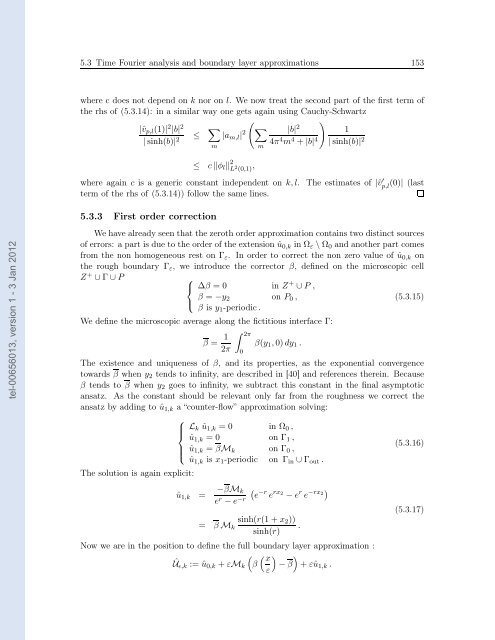Modélisation, analyse mathématique et simulations numériques de ...
Modélisation, analyse mathématique et simulations numériques de ...
Modélisation, analyse mathématique et simulations numériques de ...
You also want an ePaper? Increase the reach of your titles
YUMPU automatically turns print PDFs into web optimized ePapers that Google loves.
tel-00656013, version 1 - 3 Jan 2012<br />
5.3 Time Fourier analysis and boundary layer approximations 153<br />
where c does not <strong>de</strong>pend on k nor on l. We now treat the second part of the first term of<br />
the rhs of (5.3.14): in a similar way one g<strong>et</strong>s again using Cauchy-Schwartz<br />
|ˆvp,l(1)| 2 |b| 2 <br />
≤ |am,l|<br />
|sinh(b)| 2 2<br />
<br />
|b| 2<br />
4π4m4 +|b| 4<br />
<br />
1<br />
|sinh(b)| 2<br />
m<br />
≤ cφl 2<br />
L 2 (0,1) ,<br />
where again c is a generic constant in<strong>de</strong>pen<strong>de</strong>nt on k,l. The estimates of |ˆv ′ p,l (0)| (last<br />
term of the rhs of (5.3.14)) follow the same lines.<br />
5.3.3 First or<strong>de</strong>r correction<br />
We have already seen that the zeroth or<strong>de</strong>r approximation contains two distinct sources<br />
of errors: a part is due to the or<strong>de</strong>r of the extension û0,k in Ωε \Ω0 and another part comes<br />
from the non homogeneous rest on Γε. In or<strong>de</strong>r to correct the non zero value of û0,k on<br />
the rough boundary Γε, we introduce the corrector β, <strong>de</strong>fined on the microscopic cell<br />
Z + ∪Γ∪P ⎧<br />
⎨ ∆β = 0 in Z<br />
⎩<br />
+ ∪P ,<br />
β = −y2 on P0,<br />
(5.3.15)<br />
β is y1-periodic.<br />
We <strong>de</strong>fine the microscopic average along the fictitious interface Γ:<br />
β = 1<br />
2π<br />
2π<br />
0<br />
m<br />
β(y1,0)dy1.<br />
The existence and uniqueness of β, and its properties, as the exponential convergence<br />
towards β when y2 tends to infinity, are <strong>de</strong>scribed in [40] and references therein. Because<br />
β tends to β when y2 goes to infinity, we subtract this constant in the final asymptotic<br />
ansatz. As the constant should be relevant only far from the roughness we correct the<br />
ansatz by adding to û1,k a “counter-flow” approximation solving:<br />
⎧<br />
⎪⎨<br />
⎪⎩<br />
The solution is again explicit:<br />
Lk û1,k = 0 in Ω0,<br />
û1,k = 0 on Γ1,<br />
û1,k = βMk on Γ0,<br />
û1,k is x1-periodic on Γin ∪Γout.<br />
û1,k = −βMk<br />
e r −e −r<br />
= βMk<br />
e −r e rx2 −e r e −rx2 <br />
sinh(r(1+x2))<br />
sinh(r)<br />
Now we are in the position to <strong>de</strong>fine the full boundary layer approximation :<br />
Ûǫ,k := û0,k +εMk<br />
<br />
β<br />
x<br />
ε<br />
<br />
−β<br />
.<br />
<br />
+εû1,k.<br />
(5.3.16)<br />
(5.3.17)

















